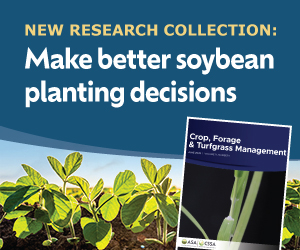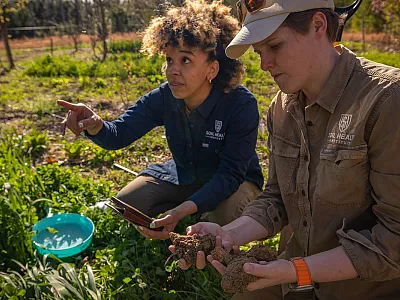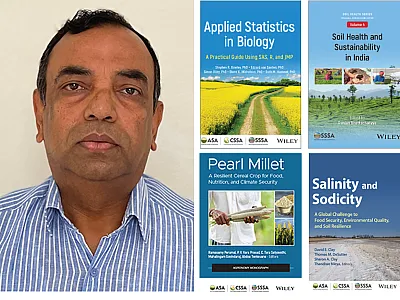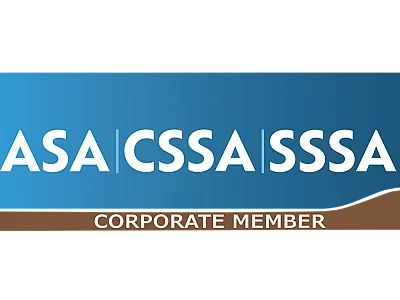Perspectives of Certified Crop Advisers on Pesticide Resistance Management

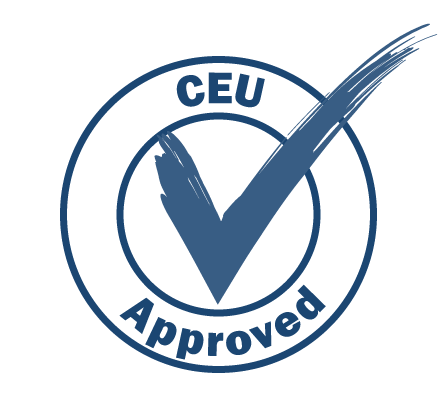
Pesticide resistance presents serious agronomic, environmental, and socio economic threats that continue to grow despite significant research and outreach initiatives. Existing research on producers’ pest management decisions and behaviors suggests that they face a variety of barriers and limitations to best management practices. While we know an increasing amount about producers’ perspectives on, and management of, pesticide resistance, there is limited understanding of how their advisers think about and deal with the issue. A recent survey sent to U.S.-based CCAs provides some insight into these questions. Earn 0.5 CEUs in Integrated Pest Management by reading this article and taking the quiz at https://web.sciencesocieties.
org/Learning-Center/Courses.
Pesticide resistance presents serious agronomic, environmental, and socio‐economic threats that continue to grow despite significant research and outreach initiatives (Heap, 2023). It has been proposed that much of this difficulty is due to the so‐called “wicked” nature of the problem; pesticide resistance has no single, simplistic cause and therefore no easy solution (Bagavathiannan et al., 2019; Dentzman, 2022). Rather, management will be a matter of significant complexity and collaboration between diverse stakeholders.
Existing research on producers’ pest management decisions and behaviors suggests that they face a variety of barriers and limitations to best management practices. These include limited resources such as time, money, and farm labor availability but also extend to networks of communication and dominant ideologies, including techno‐optimism and individualism, which place limitations on what kinds of management approaches can be imagined as practicable (Dentzman, 2022). However, while we know an increasing amount about producers’ perspectives on, and management of, pesticide resistance, there is limited understanding of how their advisers think about and deal with the issue, including how they guide producers on their management practices.
Studies that look beyond producers have focused primarily on extension educators and industry scientists, usually investigating their influence on best management practice adoption. Little research has specifically focused on the influence crop advisers have on pest resistance management practices. However, there is evidence that their role may be significant. For instance, Arbuckle (2014) found that private crop consultants were among the top three sources of information Iowa producers went to for assistance with pest management decisions. Other studies concur that crop advisers are highly influential in producers’ decision‐making process and that this role may be increasingly important (Eanes et al. 2019; Ingram 2008).
Our study sought to identify the perspectives of crop advisers on, and approaches to dealing with, pesticide resistance as key knowledge‐holders and influencers. Research questions of interest are shown in Figure 1.
Working together with the Center for Survey Statistics and Methodology at Iowa State University and the American Society of Agronomy, 2,000 U.S.‐based CCAs were sent an email invitation to complete an online survey addressing these questions in December of 2022. We received 367 completions for a 20% response rate. Of the respondents, 60% were independent CCAs, and 40% were affiliated with a specific agrochemical company such as BASF (Figure 2).
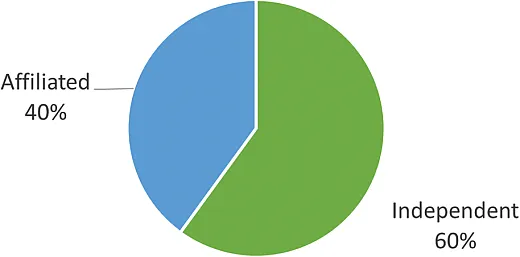
We received responses from all 50 states in the U.S. with the most responses coming from California, Iowa, Minnesota, and Ohio. Of the respondents, 90% were men and 98% were white. The majority worked with between three and five different crops; the most frequent were corn (60%), potatoes (16%), sugarbeets (9%), wine grapes (9%), soybeans (8%), and wheat (6%).
Pesticide Resistance Levels of Concern
We first looked at the levels of concern CCAs had related to different types of pesticide resistance (Figure 3). When asked about their level of concern with helping farmers manage herbicide resistance in the next five years, 40% of respondents were very concerned. This was high compared with reported insecticide resistance concern (14% very concerned) and fungicide resistance concern (8% very concerned).

Generally, CCAs tended to be more concerned about herbicide resistance when they reported working with corn, rice, or beets; had a Resistance Management Specialty (RMS) certification; were based in the southern U.S.; served a large average number of customers and acres; and were independent rather than affiliated. Similarly, CCAs were more concerned about insecticide resistance when they had an RMS certification and served a large average number of customer and acres. They were also more likely to worry about insecticide resistance issues when they worked with nuts, vegetables, or fruit. Finally, CCAs’ concern about fungicide resistance was highest when they had an RMS certification, served a large average number of customers and acres, were located in the southern or western U.S., and worked with nuts, vegetables, potatoes, beets, fruit, or wine grapes.
When asked whether various factors could make bringing up pesticide resistance with their customers difficult, our respondents highlighted that these conversations were, in general, not especially hard to initiate. However, there were certain things that made it more difficult. First among these was that customers sometimes felt pesticide resistance management was too difficult and were therefore unwilling to discuss it in depth. CCAs also highlighted customers who were tired of hearing about resistance management or who believed it would be too costly. CCAs’ own competing priorities related to making a sale or avoiding hurting their relationship with a customer were seen as minimal barriers; however, they were also ranked as more difficult for affiliated compared with independent CCAs.
Management Information Sources, Barriers

Sometimes CCAs were frustrated by conflicting information and recommendations that retailers gave to their customers. For example, 52% agreed that retailers sometimes talked the CCAs’ customers out of following their recommendations; 66% agreed that retailers sometimes make pesticide recommendations based primarily on product availability. This was seen as a particular issue given that 66% agreed it can be hard to change a customers’ mind if they have contrasting information from an outside source.
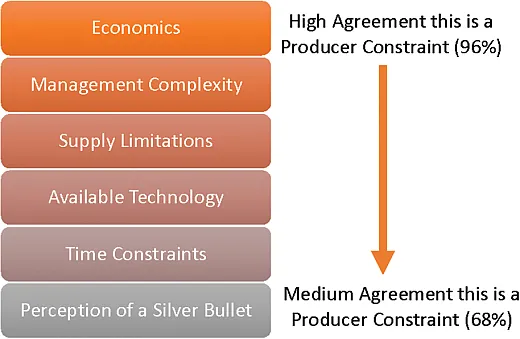
When making pesticide resistance management decisions, CCAs themselves relied primarily on four sources of information: in‐field experience, university Extension, their customers, and commodity groups (Figure 4). Customers, in turn, were reported to rely on information from crop advisers, retailers, other farmers, and university Extension. While producers and crop advisers were perceived as going to each other for information, the only third‐party information source they had in common was university Extension. This highlights the potential importance of Extension in connecting and reinforcing knowledge exchanges between producers and CCAs.
When asked to rank their customers’ constraints to following pesticide resistance best management practices, CCAs listed economics as the number one barrier followed by management complexity, supply limitations, available technology, time constraints, and the misguided perception of a silver bullet (Figure 5).
What Needs to Change?
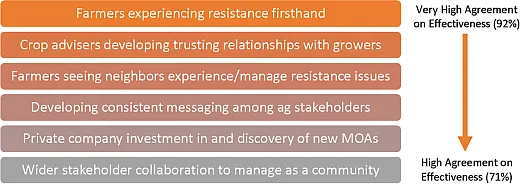
Finally, we were interested in what CCAs think needs to change to more effectively manage pesticide resistance. The number one change CCAs identified was farmers’ mindsets with 82% agreeing a shift needs to occur to effectively manage pesticide resistance. Next, at 73% agreement, was that customers needed to better understand the process of pesticide discovery, development, and commercialization. These top two changes specifically target producer attitudes and knowledge, highlighting the importance and practicality of focusing on changing values and behaviors as opposed to supply limitations and available technology, which are further removed from CCAs’ sphere of influence. Cost of solutions was also seen as a major barrier that, if altered, would be highly effective in managing pesticide resistance; however, this was ranked lower than producer mindset and knowledge shifts, potentially due to its low feasibility.
According to 92% of respondents, if farmers experienced resistance issues firsthand, that would help change their mindset and encourage best practice adoption (Figure 6). Producers experiencing pesticide resistance has, indeed, been shown to increase their concern about resistance issues; however, this does not necessarily result in best management practices and may instead create a fatalistic attitude in which producers rely more heavily on chemical pesticide innovation to “save” them (Dentzman, 2018). It will be important to direct producer concerns in a way that is productive, i.e., by increasing knowledge and practicality of integrated pest management options as real, workable alternatives (Dentzman, 2018).
Other effective drivers of pesticide resistance management that CCAs highlighted included crop advisers developing trusting relationships with growers, farmers seeing their neighbors experience and manage resistance issues, more consistent messaging among agricultural stakeholders, private company investment in discovering new modes of action, and stakeholders collaborating to manage pesticide resistance as a community. It is perhaps telling that the most highly ranked options had to do with encouraging mindset changes, building trust, and coordinating messaging. Generally, most agricultural professionals already have the knowledge of what management practices would be most effective; they are, rather, focused on encouraging the adoption of these practices (Norsworthy et al., 2012). It is also interesting to note that CCAs located in the southern U.S. were more likely to believe that community collaboration would be effective, perhaps because of familiarity with the largely successful Arkansas Zero Tolerance Program (Barber et al., 2015). There have been arguments that such collaboration is the future of pesticide resistance management (Bagavathiannan et al., 2019; Dentzman, 2022), but it appears to be more accepted by those who have seen it in action.
Key takeaways from this study include demonstrating that CCAs are broadly concerned about pesticide resistance with herbicide resistance being the most worrisome and fungicide resistance the least. The CCAs with an RMS certification and who serve more customers and acres were more likely to be highly concerned; independent CCAs were also more concerned about herbicide resistance than those affiliated with agrochemical companies. Crop types that CCAs worked with also played a major role. Generally, bringing pesticide resistance up with their customers wasn’t considered especially hard although it appeared to be more difficult when dealing with insecticide resistance or when customers were not receptive due to economics, mindset, management complexity, information fatigue, and other constraints. There was concern among CCAs about retailer recommendations conflicting with their own; this was more of an issue for independent CCAs.
Changes that need to happen to better manage pesticide resistance focused on attitude, behavior, and knowledge shifts, including changes in customer mindsets, a better understanding of the speed of innovation, and more consistent communication and messaging. Things that could potentially drive these changes included first‐ and secondhand experience of resistance issues, developing trusting relationships between CCAs and customers, and community management/support.
References
Barber, L.T., Smith, K.L., Scott, R.C., Norsworthy, J.K., & Vangilder, A.M. (2015). Zero tolerance: A community‐based program for glyphosate‐resistant palmer amaranth management (Extension Publication FSA2177). University of Arkansas System Division of Agriculture, Agriculture and Natural Resources.
Bagavathiannan, M., Graham, S., Ma, Z., Barney, J.N., Coutts, S.R., Caicedo, A.L., … & Beckie, H. (2019). Considering weed management as a social dilemma bridges individual and collective interests. Nature Plants, 5, 343–351.
Dentzman, K. (2018). Herbicide resistant weeds as place disruption: Their impact on farmers’ attachment, interpretations, and weed management strategies. Journal of Environmental Psychology, 60, 55–62.
Dentzman, K. (2022). Governance of emerging pests and pathogens in production landscapes: Pesticide resistance and collaborative governance. Current Opinion in Environmental Sustainability, 58, 101220.
Eanes, F.R., Singh, A.S., Bulla, B.R., Ranjan, P., Fales, M., Wickerham, B., … & Prokopy, L.S. (2019). Crop advisers as conservation intermediaries: Perceptions and policy implications for relying on nontraditional partners to increase US farmers’ adoption of soil and water conservation practices. Land Use Policy, 81, 360–370.
Heap, I. (2023). The international herbicide‐resistant weed database. https://www.weedscience.org/
Ingram, J. (2008). Agronomist–farmer knowledge encounters: an analysis of knowledge exchange in the context of best management practices in England. Agriculture and Human Values, 25, 405–418.
Norsworthy, J.K., Ward, S.M., Shaw, D.R., Llewellyn, R.S., Nichols, R.L., Webster, T.M., … & Barrett, M. (2012). Reducing the risks of herbicide resistance: best management practices and recommendations. Weed Science, 60(SP1), 31–62.
Self-Study CEU Quiz
Earn 0.5 CEUs in Integrated Pest Management by taking the quiz for the article at https://web.sciencesocieties.org/Learning-Center/Courses. For your convenience, the quiz is printed below. The CEU can be purchased individually, or you can access as part of your Online Classroom Subscription.
1. Which of the following types of pesticide resistance were CCAs LEAST concerned about?
a. Herbicide resistance.
b. Insecticide resistance.
c. Fungicide resistance.
d. They were concerned about all equally.
2. Which was the ONLY source of pesticide resistance information CCAs and producers had in common (other than each other)?
a. Retailers.
b. University Extension.
c. Commodity groups.
d. Friends/family.
3. Why might CCAs have focused on producer mindset and knowledge changes as effective pesticide resistance management techniques?
a. They are practical changes within CCAs’ sphere of influence.
b. New mode-of-action discovery and development is slow and costly.
c. We already know most best management practices; now we should focus on adoption.
d. All of the above .
4. Having a Resistance Management Specialty (RMS) certification increased CCAs’ concern related to herbicide, insecticide, and fungicide resistance.
a. True.
b. False.
5. Which of the following increased the agreement among CCAs that community collaboration would be an effective pesticide resistance management strategy?
a. Working in the southern U.S. (and potential familiarity with the Arkansas Zero Tolerance Program).
b. Working in the western U.S. (and potential familiarity with the Pacific Northwest Community Management Program).
c. Being independent as opposed to affiliated with an agrochemical company.
d. Working primarily with corn and soybeans.
Text © . The authors. CC BY-NC-ND 4.0. Except where otherwise noted, images are subject to copyright. Any reuse without express permission from the copyright owner is prohibited.



